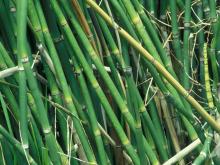Wildflowers, Grasses and Other Nonwoody Plants
Media

Species Types
Scientific Name
Chamaecrista fasciculata (formerly Cassia fasciculata)
Description
The interesting, bright yellow flowers of showy partridge pea are immediately recognizable. At night, the leaflets close and pull upward into a sleeping position.
Media

Species Types
Scientific Name
Securigera varia (formerly Coronilla varia)
Description
In summer, you’re almost guaranteed to see big colonies of crown vetch along Missouri's highways. This weedy nonnative plant stabilizes the dirt after road construction but degrades our natural ecosystems.
Media

Species Types
Scientific Name
Microstegium vimineum
Description
Japanese stiltgrass is an invasive annual grass with thin, pale green, lance-shaped leaves that are 3 inches long. It has spread to nearly every eastern U.S. state. It forms dense patches, displacing and outcompeting native species for nutrients and light.
Media

Species Types
Scientific Name
Equisetum (3 spp. in Missouri)
Description
Horsetails, or scouring rushes, are in the genus Equisetum. They’re easy to recognize with their jointed, hollow stems. Like ferns, they reproduce via spores instead of flowers and seeds.
Media

Species Types
Scientific Name
Ophioglossum spp.
Description
Four species of adder’s tongue ferns occur in Missouri. They don’t look like typical ferns. They have spoon-shaped leaves and an upright spore-bearing stalk.
Media
Species Types
Scientific Name
Vernonia baldwinii
Description
Ironweeds are tough, grayish-green, branching plants known for their fluffy-looking clusters of reddish-purple florets. They are a familiar sight on roadsides and pastures. Identify western ironweed by the bracts at the base of the flowerheads.
Media

Species Types
Scientific Name
Torilis arvensis
Description
Hedge parsley is an introduced plant that looks a lot like parsley. It was first collected in Missouri in 1909 and has become much more abundant in recent decades as it spreads along roadsides and railroads.
Media

Species Types
Scientific Name
Verbascum thapsus
Description
Mullein immigrated to America along with Europeans, and with them it has spread across the continent. Its fuzzy, green-gray rosettes of leaves and tall spikes of yellow flowers make it easy to identify.
Media

Species Types
Scientific Name
Verbascum blattaria
Description
Moth mullein is a native of Eurasia introduced to our continent in the early 1800s. Since then, it has spread across North America. It’s named because the fuzzy flower, with 2 antennalike stamens, looks something like a moth.
Media

Species Types
Scientific Name
Anemone canadensis
Description
White anemone is a showy native wildflower with interesting, deeply toothed leaves. Often occurring in colonies, it spreads easily (even aggressively) from rhizomes and is sometimes cultivated in wildflower gardens.
See Also
About Wildflowers, Grasses and Other Nonwoody Plants in Missouri
A very simple way of thinking about the green world is to divide the vascular plants into two groups: woody and nonwoody (or herbaceous). But this is an artificial division; many plant families include some species that are woody and some that are not. The diversity of nonwoody vascular plants is staggering! Think of all the ferns, grasses, sedges, lilies, peas, sunflowers, nightshades, milkweeds, mustards, mints, and mallows — weeds and wildflowers — and many more!





















